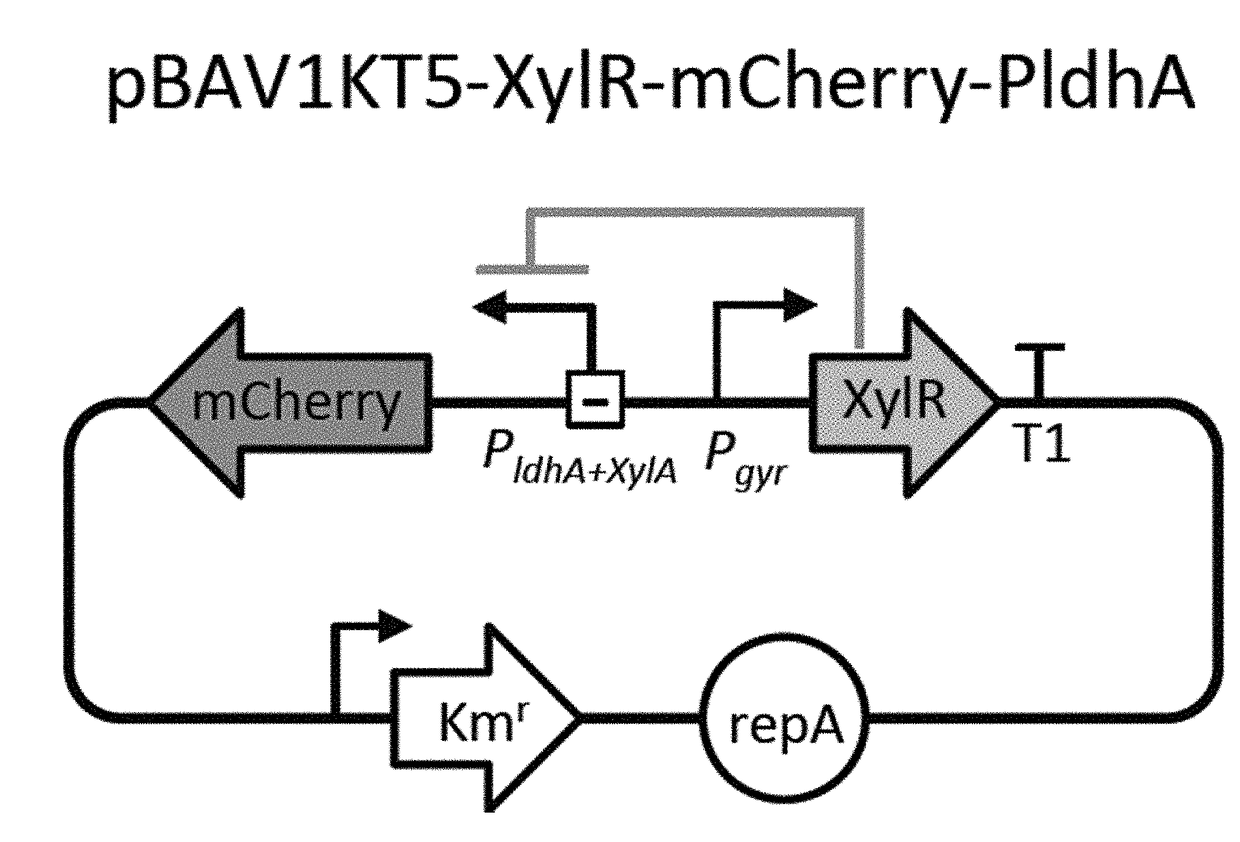Selectively altering microbiota for immune modulation
a technology of immune modulation and selective alteration, applied in the field of selective alteration of microbiota for immune modulation, to achieve the effects of reducing the growth rate of host cells, enhancing cell based therapy, and dampening cell based therapy
- Summary
- Abstract
- Description
- Claims
- Application Information
AI Technical Summary
Benefits of technology
Problems solved by technology
Method used
Image
Examples
example 1
Microbiota Bacterial Population Growth Inhibition by Harnessing Wild-Type Endogenous Cas
[0737]1. Material and Methods
[0738]1. 1. Strains
[0739]The following strains were used in the course of this Example and Examples 2 and 3: E. coli MG1655, E. coli TOP10, Streptococcus thermophilus LMD-9 (ATCC BAA-491, Manassas, Va.), Streptococcus thermophilus DSM 20617(T) (DSMZ, Braunschweig, Germany), Lactococcus lactis MG1363 and Streptococcus mutans Clarke 1924 DSM 20523 (DSMZ, Braunschweig, Germany).
[0740]During the course of media selection and testing of the genetic constructs different Streptoccoci strains were used. Streptococcus thermophilus LMD-9 (ATCC BAA-491) and Escherichia coli TOP10 were considered because of their compatible growth requirements. All strains were cultivated in Todd-Hewitt broth (TH) (T1438 Sigma-Aldrich), in aerobic conditions and at 37° C., unless elsewhere indicated. The strains were stored in 25% glycerol at −80° C.
[0741]1. 2. Differential Growth Media
[0742]All ...
example 2
Microbiota Bacterial Population Growth Inhibition in Different Strains
[0785]Example 1 demonstrated specific growth inhibition of Streptococcus thermophilus LMD-9. Here we demonstrate growth inhibition can also be obtained in a second strain: Streptococcus thermophilus DSM 20617. Methods described in Example 1 were, therefore, applied to the latter strain (except that selective media for S. thermophilus DSM 20617 was TH media supplemented with 2.5 g l−1 of 2-phenylethanol (PEA)).
[0786]Streptococcus thermophilus DSM 20617 transformed with the CRISPR array plasmids were incubated for recovery in liquid media for a period of 3 hours at 37° C. that would allow for expression of kanamycin resistance. After a recovery period, cells were plated in different selection media in presence of 1% xylose in order to induce cell death, and without xylose as a control (FIG. 10). It is evident that; (1) by xylose induction the growth of S. thermophilus can be inhibited (around 10-fold for the ‘strong...
example 3
Bacterial Population Growth Inhibition in a Mixed Consortium of Different Microbiota Species
[0787]We next demonstrated selective growth inhibition of a specific bacterial species in a mixed population of three species. We selected species found in gut microbiota of humans and animals (S thermophilus DSM 20617(T), Lactobacillus lactis and E coli). We included two gram-positive species (the S thermophilus and L lactis) to see if this would affect the ability for selective killing of the former species; furthermore to increase difficulty (and to more closely simulate situations in microbiota) L lactis was chosen as this is a phylogenetically-related species to S thermophilus (as indicated by high 16s ribosomal RNA sequence identity between the two species). The S thermophilus and L lactis are both Firmicutes. Furthermore, to simulate microbiota, a human commensal gut species (E coli) was included.
[0788]1. Materials & Methods
[0789]Methods as set out in Example 1 were used (except that s...
PUM
| Property | Measurement | Unit |
|---|---|---|
| total volume | aaaaa | aaaaa |
| total volume | aaaaa | aaaaa |
| excitation wavelength | aaaaa | aaaaa |
Abstract
Description
Claims
Application Information
 Login to View More
Login to View More - R&D
- Intellectual Property
- Life Sciences
- Materials
- Tech Scout
- Unparalleled Data Quality
- Higher Quality Content
- 60% Fewer Hallucinations
Browse by: Latest US Patents, China's latest patents, Technical Efficacy Thesaurus, Application Domain, Technology Topic, Popular Technical Reports.
© 2025 PatSnap. All rights reserved.Legal|Privacy policy|Modern Slavery Act Transparency Statement|Sitemap|About US| Contact US: help@patsnap.com



